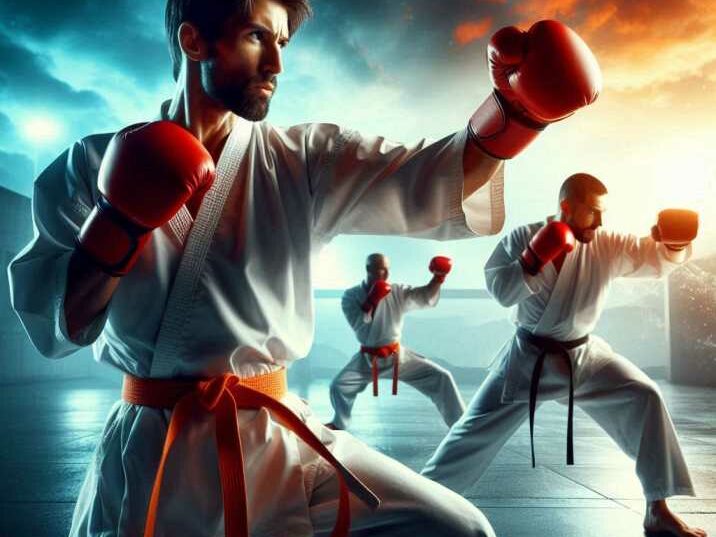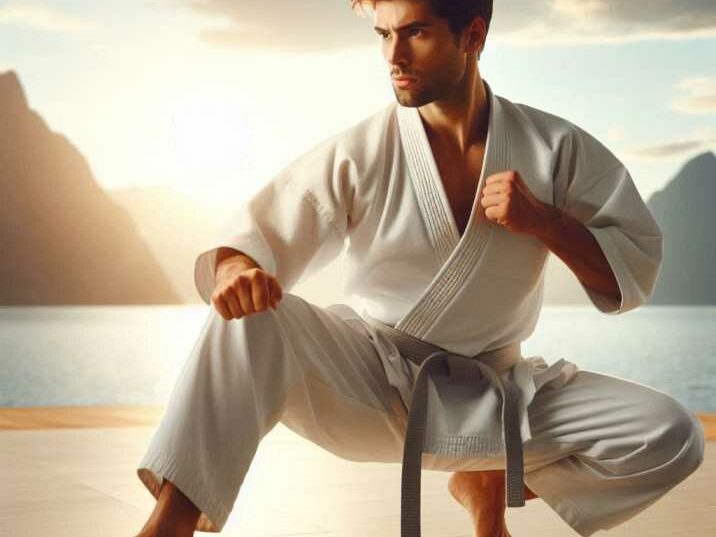Martial arts have been practiced for centuries across the globe, with karate and kickboxing being two of the most popular forms. This comprehensive guide will help you understand the differences and similarities between martial arts, karate, and kickboxing. We will explore various aspects, including history, techniques, benefits, and training tips.

Introduction to Martial Arts
Table of Contents
Martial arts are structured systems of combat practices, training, and traditions used for various reasons such as self-defense, military, and law enforcement applications, competition, physical health and fitness, mental and spiritual development, and entertainment. They have a rich history, originating from ancient civilizations and evolving over time to include numerous styles and disciplines.
History of Karate
Origins and Development
Karate, which means “empty hand” in Japanese, originated in Okinawa, Japan, during the early 20th century. Influenced by indigenous Ryukyuan martial arts and Chinese kung fu, karate evolved as a form of self-defense that focuses on striking techniques. Key figures in the development of karate include Gichin Funakoshi, who is often credited with popularizing karate in mainland Japan, and Chojun Miyagi, the founder of Goju-Ryu karate.
Key Figures
- Gichin Funakoshi: Known as the father of modern karate, he established Shotokan karate and introduced the practice to Japan.
- Chojun Miyagi: Founder of Goju-Ryu karate, Miyagi emphasized the balance between hard and soft techniques.
- Kenwa Mabuni: Founder of Shito-Ryu karate, he combined elements from various traditional styles to create a comprehensive system.
History of Kickboxing
Evolution from Traditional Martial Arts
Kickboxing is a hybrid martial art that combines elements of traditional karate, Muay Thai, and Western boxing. It originated in Japan in the 1960s as a competitive sport and gained popularity worldwide. The sport was developed to provide a platform where practitioners from different martial arts backgrounds could compete under a unified set of rules.
Key Developments
- 1960s Japan: The creation of kickboxing by combining techniques from karate and Muay Thai.
- 1970s USA: Kickboxing became popular in the United States, leading to the establishment of various kickboxing organizations and competitions.
- Modern Era: Kickboxing is now a recognized sport worldwide, with professional and amateur leagues, as well as fitness-focused variations.
Techniques in Karate
Basic Moves
Karate techniques are divided into three main categories: kihon (basics), kata (forms), and kumite (sparring).
- Punches (Tsuki): The straight punch (oi-tsuki) and reverse punch (gyaku-tsuki) are fundamental.
- Kicks (Geri): Basic kicks include the front kick (mae-geri), roundhouse kick (mawashi-geri), and sidekick (yoko-geri).
- Blocks (Uke): Basic blocks such as the upper block (age-uke), middle block (chudan-uke), and lower block (gedan-barai) are essential for defense.

Katas
Katas are choreographed patterns of movements that simulate fighting multiple opponents. They are critical for developing technique, balance, and muscle memory.
Sparring
Sparring, or kumite, is the practice of fighting an opponent under controlled conditions. It allows practitioners to apply techniques in real-time, improving reflexes and strategic thinking.
Techniques in Kickboxing
Fundamental Strikes
Kickboxing combines various striking techniques, including punches, kicks, and knee strikes, to create a versatile and effective martial art.
Punches
- Jab: The jab is a quick, straight punch thrown with the lead hand. It’s used to gauge distance, keep the opponent at bay, and set up other strikes.
- Cross: The cross is a powerful, straight punch thrown with the rear hand. It follows the jab and aims to deliver significant impact.
- Hook: The hook is a punch delivered in a circular motion with the lead or rear hand. It targets the side of the opponent’s head or body, often used in close-range combat.
- Uppercut: The uppercut is an upward punch aimed at the opponent’s chin or torso. It’s highly effective in close quarters and can be a knockout blow.
Kicks
- Front Kick (Teep): The front kick is a straight, pushing kick delivered with the ball of the foot. It can be used to keep the opponent at a distance or to strike their midsection.
- Roundhouse Kick: The roundhouse kick is a powerful, swinging kick delivered with the shin or instep. It targets the opponent’s head, body, or legs and is one of the most common kicks in kickboxing.
- Sidekick: The sidekick is a thrusting kick delivered from the side, using the heel. It’s effective for targeting the opponent’s midsection or head.
- Low Kick: The low kick targets the opponent’s thighs with a swinging motion. It’s used to weaken the opponent’s legs, reducing their mobility and power.
Knees
- Knee Strikes: Knee strikes are powerful close-range attacks delivered with the knee. They are often used in clinch situations where the fighter can control the opponent’s head or body, delivering devastating blows to the midsection, ribs, or head.
Defensive Moves
Defensive techniques include blocking, parrying, slipping, and footwork to avoid strikes. Clinching is also an essential aspect of defense, allowing fighters to control their opponent’s movements.
Combinations
Combining different strikes into fluid sequences is crucial in kickboxing. Common combinations include jab-cross-hook, jab-low kick, and knee-strike combinations.
Benefits of Practicing
Physical Benefits
- Fitness: Both karate and kickboxing provide a full-body workout, improving cardiovascular health, strength, and flexibility.
- Coordination and Balance: Regular practice enhances motor skills and balance.
- Weight Management: High-intensity training helps in burning calories and managing weight.
Mental Benefits
- Discipline and Focus: Martial arts training instills discipline, improves concentration, and helps in setting and achieving goals.
- Stress Relief: Physical activity and mental focus help in reducing stress and anxiety.
- Self-Confidence: Learning self-defense techniques boosts self-esteem and confidence.
Social Benefits
- Community: Training in a dojo or gym fosters a sense of community and camaraderie among practitioners.
- Respect and Humility: Martial arts teach respect for others and humility through the practice of bowing and adhering to a code of conduct.
Training Tips
Getting Started
- Choose the Right School: Look for reputable dojos or gyms with qualified instructors.
- Set Clear Goals: Define what you want to achieve, whether it’s fitness, self-defense, or competition.
- Start Slow: Begin with basic techniques and gradually increase the intensity of your training.
Common Challenges
- Physical Demands: Martial arts training can be physically demanding. It’s essential to listen to your body and rest when needed.
- Mental Challenges: Maintaining focus and discipline can be tough, but consistency is key.
- Overcoming Plateaus: Progress may slow down over time. Keep motivated by setting new goals and seeking guidance from your instructors.
Safety and Equipment
Essential Gear
- Karate: Gi (uniform), belt, mouthguard, and protective gear such as gloves and shin guards.
- Kickboxing: Boxing gloves, hand wraps, mouthguard, shin guards, and sometimes headgear.
Injury Prevention
- Warm-Up and Cool Down: Always start with a warm-up and end with a cool-down to prevent injuries.
- Proper Technique: Focus on learning and practicing the correct techniques to avoid strain and injury.
- Listen to Your Body: Pay attention to any signs of discomfort or pain and address them promptly.
Safety Guidelines
- Supervision: Train under the supervision of qualified instructors.
- Controlled Environment: Ensure that sparring and practice sessions are conducted in a safe and controlled environment.
- Respect Rules: Follow the rules and guidelines set by your dojo or gym to maintain a safe training atmosphere.
Karate vs. Kickboxing
Key Differences
- Focus: Karate emphasizes traditional techniques, forms, and self-discipline, while kickboxing focuses more on competitive sport and fitness.
- Techniques: Karate includes a variety of strikes, blocks, and katas, whereas kickboxing combines punches and kicks with an emphasis on combinations and power.
- Training Style: Karate training often includes kata practice and formal sparring, while kickboxing training is more focused on high-intensity drills and sparring.
Similarities
- Striking Arts: Both martial arts involve striking techniques using punches and kicks.
- Physical and Mental Benefits: Both provide significant physical fitness and mental discipline benefits.
- Self-Defense: Both can be used effectively for self-defense.
Choosing the Right One for You
Consider your personal goals and preferences when choosing between karate and kickboxing. If you are interested in traditional martial arts with a focus on discipline and forms, karate might be the right choice. If you prefer a high-intensity workout with a focus on competitive sport, kickboxing could be more suitable.
Table of Information
| Subtopic | Key Points |
|---|---|
| Introduction to Martial Arts | Definition, brief history, and significance |
| History of Karate | Origins, development, and key figures |
| History of Kickboxing | Evolution from traditional martial arts to modern sport |
| Techniques in Karate | Basic moves, katas, and sparring |
| Techniques in Kickboxing | Fundamental strikes, defensive moves, and combinations |
| Benefits of Practicing | Physical, mental, and social advantages |
| Training Tips | Getting started, common challenges, and overcoming them |
| Safety and Equipment | Essential gear, injury prevention, and safety guidelines |
| Karate vs. Kickboxing | Key differences, similarities, and choosing the right one for you |
| FAQs | Common questions answered |
Conclusion:
In conclusion, Karate and Kickboxing offer more than just physical training; they embody principles of discipline, respect, and personal growth. Whether you’re a beginner or an expert, these martial arts provide a path to self-discovery and empowerment. So, embrace the journey, train hard, and let the spirit of martial arts guide you towards a life of strength, integrity, and inner peace.
FAQs
1. Can I practice both karate and kickboxing?
Yes, many practitioners cross-train in multiple martial arts to diversify their skills and improve overall fitness.
2. Is karate or kickboxing better for self-defense?
Both karate and kickboxing offer effective self-defense techniques. The best choice depends on your personal preference and training goals.
3. How long does it take to get a black belt in karate?
It typically takes several years of consistent training to earn a black belt in karate, usually between 4 to 7 years, depending on the school and individual progress.
4. Are Karate and Kickboxing suitable for children?
Yes, Karate and Kickboxing are suitable for children, as they promote discipline, focus, and physical fitness in a safe and structured environment.
5. Can I compete in tournaments or matches if I practice Karate or Kickboxing?
Yes, both Karate and Kickboxing offer opportunities for competition at various levels, from local tournaments to international championships, depending on your skill level and goals.


